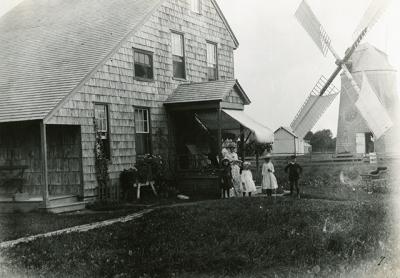Historical Cottage May House Art

The mill cottage on the Lion Gardiner home lot at 36 James Lane is going to become a museum devoted to 19th and early-20th-century landscape paintings, if plans described at a meeting of the East Hampton Village Zoning Board of Appeals on Friday come to fruition. The board appeared likely to approve a special permit and variances that would be required.
Speaking at the meeting on Friday, Robert Hefner, the village’s director of historic services, said, “The intent is to use this as a gallery of East Hampton landscape paintings of the 19th and early-20th centuries.” He called a museum “an appropriate use for this property that was preserved as a historic landscape as Lion Gardiner’s home lot.”
The special permit is required because the cottage is a pre-existing and nonconforming structure in a residential district. A variance to make alterations and eliminate nonhistorical components of the building would be necessary, as well as variances from required setbacks and parking spaces. The plan also will need approval from the design review board.
At the request of the village board, the Town of East Hampton bought the home lot, which includes the 1804 Gardiner windmill, in October 2014, using money from the community preservation fund. In December that year, the municipalities signed an agreement giving the village sole responsibility for the lot.
Plans call for the East Hampton Historical Society to be the museum’s curator, with the exhibition made possible by a grant from the Robert David Lion Gardiner Foundation. The grant, which he called “very significant,” will go toward the acquisition of part of the East Hampton Wallace Gallery’s collection. Contacted after the meeting, Terry Wallace said most of the paintings, which date from about 1865 to 1900, have been in his collection “for quite a while.” He said some would be a gift to the historical society.
The mill cottage is a timber-frame saltbox. Mr. Hefner said the village would restore it to its 1880s appearance, when Jonathan Thompson Gardiner renovated it. The artist Percy Moran, a nephew of Thomas Moran, lived there in the early-20th century.
Referring to the Gardiner Foundation, Mr. Hefner said, “Their gift to the historical society to acquire this outstanding collection will make this, right away, into a very high-quality, small-scale museum.” The art will be displayed on the cottage’s first floor, with an office and storage upstairs.
The nonhistorical additions to the cottage, including porches and dormers, are to be removed, Mr. Hefner said, and its 1880 porch reconstructed. A kitchen wing would be reconstructed, providing an entrance and bathroom complying with the Americans With Disabilities Act.
“We’re going to be removing the pavement in the front lawn to restore a grass setting between the mill cottage and the windmill,” Mr. Hefner said. The existing driveway from Maidstone Lane will remain and lead to four parking spaces. All parking would be directly behind the cottage, however, “to maintain that open vista from James Lane,” he said.
The cottage’s floor area would fall by more than half, from 3,547 to 1,471 square feet. Paved areas would be reduced by 2,000 square feet. “When you stop and think that this 3.7-acre parcel could have accommodated a 10,200-square-foot new house,” Frank Newbold, the board’s chairman, said, “this is a good outcome.” The hearing was closed.
In other news from the meeting, the application of the Maidstone Club for approval to build a bridge across the northern section of Hook Pond was adjourned at the club’s request amid growing criticism from the public and the Ladies Village Improvement Society. The hearing, which began in October, is scheduled to resume on Jan. 27.
The board also announced two decisions on Friday. Gregory and Lisa Wilson were granted variances allowing reconstruction of much of their existing house and attached garage at 30 the Circle. Alterations and a walkway fall within the required front-yard setback. The variances were granted on the condition that the house’s roof be redesigned and constructed so that it is no higher than 21 feet.
The board granted Graham Clempson variances to put a foundation under an accessory building at 56 David’s Lane that falls within required side-yard setbacks.
It wasn’t St. Nicholas, but another esteemed figure bearing gifts who visited the board that day. Mayor Paul F. Rickenbach Jr. presented a daybook to each board member and thanked them for their “due diligence, caring, and examination of the oh-so-many exercises that come before you, especially over the past 12 months.”
The village, he said, “is very dynamic, it’s diverse, and very much alive, well, and kicking. The important thing is that we maintain where we are today, having known where we came from, and looking ahead into the future.”
